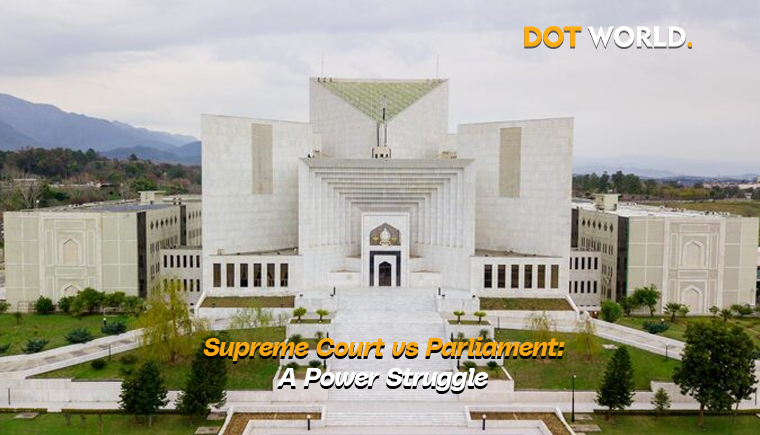In Pakistan’s turbulent political history, one struggle has echoed louder than most — the ongoing tension between the Supreme Court Pakistan and the Parlimant. This clash isn’t just a legal matter; it’s a fundamental test of how democracy works in the country.
Both institutions claim to uphold the constitution, yet time and again they find themselves locked in high-stakes confrontation. The result? A continuous loop of political conflict that hampers governance, slows reforms, and keeps the nation teetering between rule of law and political chaos.
But what fuels this power struggle? And what are its consequences for the people of Pakistan?
⚖️ The Role of Supreme Court Pakistan
The Supreme Court Pakistan is the highest judicial authority in the country. Its role is to:
- Interpret the constitution
- Uphold fundamental rights
- Ensure laws passed by the Parlimant are constitutional
- Act as the final arbiter in legal disputes, especially those involving the state
Over the years, the court has also emerged as a political actor — stepping in where executive or legislative branches faltered.
🏛️ The Parlimant: Voice of the People
On the other hand, the Parlimant — comprising the National Assembly and Senate — is the embodiment of people’s will. Its powers include:
- Lawmaking
- Budget approval
- Government accountability
- Amending the constitution
But while the Parlimant holds legislative supremacy on paper, its practical authority is often challenged by judicial interventions.
🧨 Where It All Began: A Historical Power Imbalance
The struggle between Supreme Court Pakistan and Parlimant isn’t new. It traces back to Pakistan’s early years.
1. Doctrine of Necessity
This controversial legal doctrine allowed courts to validate military coups in 1958, 1977, and 1999. In doing so, the Supreme Court Pakistan arguably overstepped its bounds, undermining the constitution to accommodate non-democratic forces.
2. Judicial Activism in the 2000s
Under Chief Justice Iftikhar Muhammad Chaudhry, the court became highly activist. Suo moto notices, high-profile disqualifications, and interventions in executive decisions marked a new era — and ignited a long-lasting political conflict.
📌 Recent Flashpoints: When Courts and Parliament Collide
🧾 1. Disqualification of Prime Ministers
In 2012, PM Yousaf Raza Gillani was disqualified over contempt charges. In 2017, Nawaz Sharif was disqualified in the Panama Papers case. Both decisions were delivered by the Supreme Court Pakistan, leading to loud cries of “judicial overreach” from elected lawmakers.
🧾 2. Election Date Rulings
In 2023, the Supreme Court Pakistan ruled that elections in Punjab and KP must be held within 90 days after assembly dissolution, contradicting the federal government’s timeline. The Parlimant retaliated by attempting to limit the court’s powers via the Supreme Court (Practice and Procedure) Act — yet another chapter in the political conflict.
🧾 3. Review of Legislation
The court has repeatedly suspended or nullified laws passed by the Parlimant, citing constitutional violations — while lawmakers argue that judicial review cannot override the people’s mandate.
🧭 Who’s Right? The Battle of Legitimacies
At the heart of the issue is a philosophical debate:
| Supreme Court Pakistan | Parlimant |
| Guardian of the Constitution | Voice of the People |
| Independent of politics | Accountable to voters |
| Can override unconstitutional laws | Can amend the Constitution |
This tension is normal in democracies — but in Pakistan, it often turns toxic. Lack of mutual respect between institutions escalates routine disagreements into national crises.
📉 Impact of the Power Struggle on Governance
The constant tug-of-war between judiciary and legislature leads to:
- Policy Paralysis: Government decisions get stuck in courtrooms
- Political Instability: Frequent court interventions weaken elected leaders
- Public Distrust: People lose faith in all institutions
- Legal Confusion: Conflicting interpretations of the constitution create uncertainty
Most importantly, it distracts from issues like inflation, unemployment, education, and health — where real reform is needed.
🧑⚖️ Judiciary: A Neutral Arbiter or Political Actor?
Critics say the Supreme Court Pakistan has occasionally acted more like a political opposition than a neutral referee.
Examples include:
- Issuing frequent suo moto notices
- Ruling on matters better left to policymakers
- Taking up politically sensitive cases during election seasons
While judicial activism is sometimes necessary, unchecked interference creates a parallel power structure that undermines the Parlimant.
🗣️ Parliament’s Pushback: Defending Its Turf
The Parlimant isn’t silent either. Recent years have seen:
- Laws to curb judicial authority
- Attempts to regulate the Chief Justice’s powers
- Parliamentary resolutions criticizing court decisions
While asserting its legislative supremacy is legitimate, doing so in reaction to personal or party interests damages the sanctity of democratic institutions.
📜 The Constitution: Source of Clarity or Confusion?
Ironically, both sides claim to defend the constitution — but interpret it in ways that support their own actions.
For example:
- Article 69 protects parlimant proceedings from court interference
- Article 184(3) allows Supreme Court Pakistan to act in matters of public importance
The vagueness and broad scope of such clauses allow both institutions to push their boundaries — and thus fuel political conflict.
🔄 A Vicious Cycle
Pakistan’s history shows a repeating pattern:
- Parliament passes a controversial law
- Supreme Court steps in to block or modify it
- Government retaliates through constitutional amendments
- Political tension rises
- Real governance suffers
Unless a clear boundary is drawn, this loop will continue indefinitely.
🛑 What Needs to Change?
To break this cycle, both institutions must:
✅ Respect Constitutional Roles
Neither should encroach on the other’s domain.
✅ Ensure Institutional Dialogue
Instead of acting through confrontations, issues should be resolved through structured consultation.
✅ Reform the Judicial Appointment System
Current methods lack transparency. More parliamentary oversight is needed — but without politicization.
✅ Public Accountability
Both courts and the parlimant must work transparently to regain public trust.
📣 Voices from Civil Society
Legal experts, journalists, and civil society organizations have voiced growing concerns over this power struggle. They argue that:
- Judicial reforms are essential but must be inclusive
- The constitution should be clarified through consensus, not confrontation
- Power should be decentralized to reduce central-level conflicts
“The Supreme Court cannot function as a parallel parliament, and the Parliament cannot function without judicial oversight.”
🧭 Global Comparisons
Other democracies face similar tensions, but manage them through institutional maturity.
| Country | Court vs Parliament Cases | Resolution |
| UK | Brexit rulings vs Parliament | Dialogue & legal reform |
| India | Farm laws & judiciary disputes | Judicial restraint |
| US | Roe v. Wade & Congress | Checks & balances |
Pakistan must follow suit by strengthening constitutional mechanisms — not personal egos.
🧾 Conclusion: Clash of Equals or Misplaced Power?
The Supreme Court Pakistan and the Parlimant are both pillars of the state — but their ongoing political conflict threatens to erode public faith in both. While courts claim to defend the law, and lawmakers claim to defend the people, it is the nation that suffers in the crossfire.
A functioning democracy cannot afford institutional wars. It demands cooperation, constitutional clarity, and above all — humility.
Only when the court upholds justice without bias, and the parlimant governs with integrity, can Pakistan rise beyond the tug-of-war and deliver true democratic dividends to its people.





